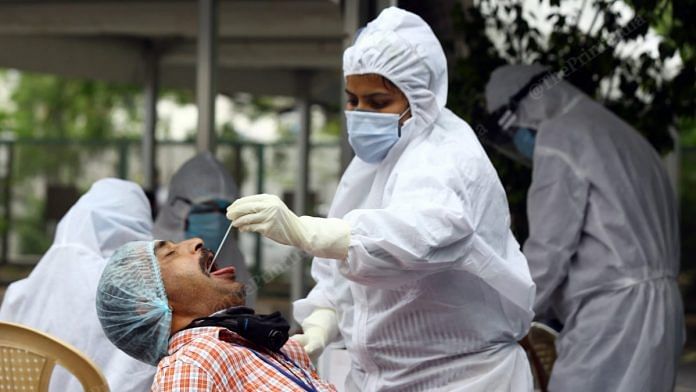New Delhi: The Covid-19 lockdown should continue in Maharashtra, Delhi, Rajasthan, Gujarat, Uttar Pradesh, Madhya Pradesh, Telangana, and Tamil Nadu beyond 3 May, researchers at IIT-Mandi have said.
A team of researchers at the institute has developed a short-term forecasting model to analyse which states should be able to lift the lockdown after Sunday, when the second phase of the restrictions are scheduled to end.
Their forecasts reveal that Delhi, Rajasthan, Gujarat, Uttar Pradesh, Madhya Pradesh, Telangana, and Tamil Nadu will be the most-affected states in the coming days. The lockdown should not be lifted in these states, the team recommends.
The study has been conducted by Dr Sarita Azad, assistant professor at IIT-Mandi, and her PhD student Neeraj Poonia. It has yet to be peer-reviewed.
Also Read: India’s tourism needs life support, liquidity to survive Covid crisis: MakeMyTrip founder
No relief soon
The study used data from 30 January to 21 April to predict how cases will increase for different states over the next 10 days.
The results show that the number of cumulative cases in India will rise to 36,335, with 1,099 deaths by 1 May.
As of Wednesday, the number of nationwide cases and deaths stands at around 31,332 and 1,007, respectively.
Based on the number of cumulative cases as on 1 April, the team also classified different areas of the country into severity zones.
While Delhi, Rajasthan, Uttar Pradesh, Maharashtra, Telangana, Karnataka, Kerala, Tamil Nadu, which are severely affected, were classified as ‘red zones’, seven states and union territories deemed to be “intermediately affected” have been labelled ‘blue zones’: Jammu & Kashmir, Punjab, Haryana, Gujarat, Madhya Pradesh, Andhra Pradesh, and West Bengal.
The green and light green – least-affected – zones are Himachal Pradesh, Uttrakhand, Bihar, Jharkhand, Chhattisgarh, Odisha, Sikkim, Arunachal Pradesh, Assam, Nagaland, Manipur, Mizoram, Tripura, Meghalaya, and Goa.
However, the team’s predictions show that by 1 May, Kerala and Karnataka are likely to shift from red to the blue zone. On the other hand, Gujarat and Madhya Pradesh will move to the red zone.
The eight red zone states accounted for 26,242 cases, or approximately 84 per cent of India’s total, as of Wednesday.
The states in the green zone are likely to show very less growth in the number of infected cases by 1 May.
The researchers validated the results by using their model to make predictions for the number of infected cases and deaths for 12 April, arriving at a figure of 8,064 to 8,936.
According to the data from Worldometer, a reference website, the cumulative cases for 12 April stood at 9,205, a maximum variation of 12 per cent.
Also Read: This is how India’s Left and Right read Covid-19 numbers differently




What’s new in this report ? For such a common sense, they need to develop a model…
Waste of talent
IIT publishing a report which looks like more like copy paste. ???For such a common sense analysis you need to develop a model..??!!!.it will be better if IIT gives better inputs like ,how can organisation instead of having one centralised office at bkc which requires employees to travel from borivali decentralised and creates a small work place in borivali.similary for navi mumbai.This is the only way social distancing can be maintained in Mumbai. Even if there is onr covid suspect and Mumbai local train starts..within 15 days situation will be worst.90% of employees who sit in office do not require any other person physical presence to complete his work …then why the daily travel ?.infact by creating small workplaces/offices and aligning employees accordingly , ,employee productivity will go up and savings in rental. E.g offices s in bkc leave by 530 offices in andheri by 6 …etc.Some better ideas are expected from institute like IIT. Sau for e.g if hdfc creates three sub offices say navi mumbai ,borivali ,dadar will it not reduce load on infrastructure?
How about Maharshtra? The state currently at the top of the list?